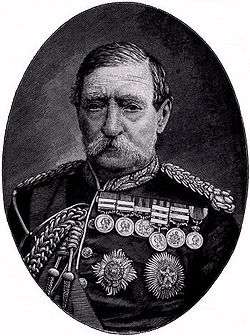Royal School of Military Engineering
| Royal School of Military Engineering | |
|---|---|
|
Badge of the Royal Engineers | |
| Active | 1812 – Present |
| Country |
|
| Branch |
|
| Type | Training |
| Role | Engineer Training |
| Part of | Army Recruiting and Training Division |
| Garrison/HQ | Chatham, Kent |
| Commanders | |
| Current commander | Brigadier D Southall OBE (Late RE) |
The Royal School of Military Engineering (RSME) Group provides a wide range of training not only in all the engineering disciplines that are fundamental to the Royal Engineers, but also Military Working Animals; their handlers and maintainers, Explosive Ordnance Disposal and Military Musicians. The scope of training delivered by the RSME Group is vast ranging from combat engineers to Army musicians, chartered engineers to veterinary technicians and bomb disposal operators to heavy plant operators.
History
The Peninsular War (1808–14) revealed deficiencies in the training and knowledge of officers and men in the conduct of siege operations and bridging. During this war low ranking Royal Engineers officers carried out large scale operations. They had under their command working parties of two or three battalions of infantry, two or three thousand men, who knew nothing in the art of siegeworks. Royal Engineers officers had to demonstrate the simplest tasks to the soldiers often while under enemy fire. Several officers were lost and could not be replaced and a better system of training for siege operations was required. The need for a school was highlighted by problems experienced during the Siege of Ciudad Rodrigo In January 1812 and the Siege of Badajoz in March 1812.[1]
On 23 April 1812 an establishment was authorised, by Royal Warrant, to teach "Sapping, Mining, and other Military Fieldwork's" to the junior officers of the Corps of Royal Engineers and the Corps of Royal Military Artificers, Sappers and Miners.
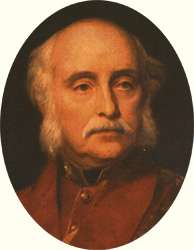
Captain Charles Pasley who had been pressing for such an establishment since 1809 was selected as the first Director with the rank of major. The location chosen was Chatham which was, at that time, a strongly fortified naval town. The town was surrounded by batteries, bastions and ditches designed to be defended by 7000 men and so provided excellent areas for training in siege operations. (Records show that there had been a military base on the high ground above Chatham built to defend Chatham Dockyard since at least 1708.) Charles Pasley received his orders to move from Plymouth on 2 May 1812 and ten days later he was in Chatham.
In 1815 Pasley recommended that the Royal Sappers and Miners Training Depot at Woolwich be closed, to concentrate all training at Chatham. But that was not achieved until 1850 when the training Depot was moved to Brompton Barracks, Chatham. The move was made possible by the completion of North Kent Railway, which facilitated a fast transport link into London. The Headquarters of the Royal Engineers, also based in Woolwich, was not moved to Chatham until 1857.
The first courses at the Royal Engineers Establishment were done on an all ranks basis with the greatest regard to economy. To reduce staff the NCOs and officers were responsible for instructing and examining the soldiers. If the men could not read or write they were taught to do so and those that could read and write were taught to draw and interpret simple plans. The Royal Engineers Establishment quickly became the centre of excellence for all fieldwork's and bridging. Pasley was keen to confirm his teaching and regular exercises were held as demonstrations or as experiments to improve the techniques and teaching of the Establishment. From 1833 bridging skills were demonstrated annually by the building of a pontoon bridge across the Medway which was proved by the infantry of the garrison and the cavalry from Maidstone. These demonstrations had become a popular spectacle for the local people by 1843, when 43,000 came to watch a field day laid on to test a method of assaulting earthworks for a report to the Inspector General of Fortifications. In 1869 the title of the Royal Engineers Establishment was changed to "The School of Military Engineering" (SME) as evidence of its status, not only as the font of engineer doctrine and training for the British Army, but also as the leading scientific military school in Europe.
Its range of courses at this time included instruction in:
- Field fortifications
- Siege works & mining
- Demolitions
- Fitting & Lathe work
- Bridging
- Stoking & management of steam boilers
- Engine driving
- Electric light in field operations
- Electricity & telegraphy
- Model making
- Woodworking machinery
- Photography & chemistry
- Ballooning
- Survey
- Submarine mining
- Railway work
- Lithography (printing)
- Estimating & building construction
At the start of World War I the Royal Engineer battalions based at Chatham were deployed to defend the local area. Immediately recruits started to arrive - in the first six weeks of the war 15,000 men arrived. A hundred recruits per day had been expected to arrive but they arrived at a rate of two hundred rising to a peak of nine hundred per day. The Depot coped so well with this influx that on 3 October 1914, the King and Queen paid a private visit to the Corps, 12,001 all ranks were on parade in uniform on the Great Lines.
The courses at Chatham had to change to produce soldiers at the rate required by the war. Training in the Construction, Survey and Electrical Schools was cut back to allow for increases in fieldwork's and military training. Recruit courses were cut from eight months to four months and a batch of thirty officers arrived every month for five months training. After the war, the SME returned to its peacetime training role. In 1920 officers started to go to Cambridge University for one year courses. This was limited to wartime officers who then also had to do one year at SME, but by 1926 all officers spent two years at Cambridge University, after their course at SME, and received a degree. Between the wars sports were an important part of life at SME.
The barracks had an open-air swimming pool. New sports fields were built on the Black Lion fields, and a new hockey ground was built to the north of the Great Lines. The enthusiasm for sports went so far that in 1921 three tennis courts were marked out on Brompton Barracks square and were used frequently.
In 1939 SME mobilised again and the Training Battalion left Chatham forming two training battalions at Harper Barracks Ripon and Shorncliffe Army Camp.
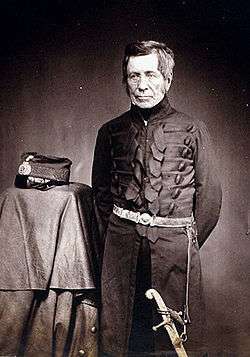
Young Officer training was cut short to allow the officers to be dispatched to units. No basic training was now done at Chatham since the officers were trained at the RE OCTU and the men were to be trained in the training battalions. Specialist, instructor and higher trade continued at Chatham but from June 1940 training was seriously interrupted by German efforts to destroy the dockyard. Approximately 100 bombs, and one Spitfire, fell on the SME damaging buildings including the Commandant's residence. One caused heavy casualties when it burst in the basement of a barrack block. Staff and students were also required to direct the building of defences in the dockyard and the surrounding area. It was difficult to continue training under these circumstances so it was decided to look for a new site for SME. In September 1940 the decision was taken to move to Ripon. Despite the disruptions caused by the move, only one month's training was lost. Trade training remained at Chatham throughout the war due to the difficulty of finding suitable workshops elsewhere. The school at Ripon was expanded to keep pace with the growing demands of the war. In 1940 an Experimental Tunnelling Section was formed and in 1941 Assault Engineer and Bomb Disposal Schools were formed. The schools ran a wide range of courses for all arms and the long courses were designed to be taken in sections so that students could attend the relevant parts.
After the war SME remained at Ripon while a decision was made about the future location of the school. Several sites with better training facilities were considered but the Treasury could not afford the cost of providing new quarters and SME returned to Chatham. The move back was completed in March 1950. The close relationship the SME had with the civilian population led to the Corps being granted the Freedom of Ripon before the departure of the SME in July 1949. The SME was also involved in the parades granting the Freedom of Gillingham in September 1953 and of Rochester in May 1954.
In 1950 trade training courses were six months long, and these were put to good use around the barracks. By 1953 they had built Burgoyne House for the Mess Secretary and Napier House for the Institution Secretary. In 1962 the School of Military Engineering celebrated its 150th birthday, and as a birthday present HM The Queen bestowed the Royal title on the School, becoming The Royal School of Military Engineering (RSME). This was announced by HRH The Duke of Edinburgh when he visited Chatham to lay the foundation stone for a new barracks for the RSME at Chattenden Camp, to house Fieldwork's, Signal and Tactics Schools and to provide accommodation for Plant, Roads and Airfields School.
In 1993 Battlefield Engineer Wing moved from Chatham to Minley. In 2006 the Defence Animal Centre came under the command of the RSME and this was followed by the Defence Explosive Ordnance Disposal, Munitions and Search Training Regiment in 2011 and more recently in 2012 by the Royal Military School of Music to form the RSME Group as we know it today.
The Corps Museum in Chatham is the ideal place to delve into the rich history of the Royal Engineers.
Curriculum history

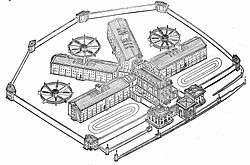
Some of the original subjects taught and innovations included:
Field fortification This was the original course of instruction and covered: field defence, siege works, bridging, demolition. Railway work was introduced in the 1830s.
Survey First introduced in 1833, covered Technical Surveying and Military Topography. This led to officers and soldiers conducting surveys (e.g. India 1820-1947, Palestine1865-83, and Uganda railway 1890's) and boundary commissions throughout the world, (e.g. North American 1843 and 1858, Russo-Afghan 1884, Gambia 1890, Kenya 1892 and Chile-Argentine 1902). Both tasks are still practiced to this day.
Electricity First introduced in the 1830s, covered battery construction, telegraphy, firing of mines, and electric light (search-lights) - From this department grew; the Army Signals Service, which became the Corps of Royal Signals (1920) and the Royal Electrical and Mechanical Engineers (1942). The Professional Engineer Wing of the School still qualifies Clerks of Works, Engineering Technicians, Incorporated Engineers and Chartered Engineers in Electrical Engineering and trains electricians for deployment with the Corps.
Photography and Chemistry First introduced in the early 1850s just before the Crimean war (1854–56) because its potential as a method of photo-reconnaissance was seen. Captain (later Sir) William de Wiveleslie Abney RE, whilst acting as department head in the 1870s, invented the photolithographic process called `Papyrotype'. The interest in chemistry continued through to the First World War and gave rise to the development, by the Corps, of chemical weapons in response to the German use of poison gas in 1915.
Lithography First introduced into the curriculum in the 1850s. It was invented in 1798 as a method of printing using stones.
Diving and Submarine mining This subject was of a personal interest to Pasley, who introduced it in 1838. To trained divers in coast defence, underwater demolition, guided torpedoes (Brennan torpedo) and port wreck clearance.
Estimating and Building Construction First introduced in the 1830s and included: building materials, sewerage, drainage, ventilation, gas and water supply, building design and architecture. Architecture was introduced in 1825 and by the 1840s onwards, this department was training world-class building designers and architects; men such as Lieutenant Colonel George Barney (designer of Victoria Barracks, Sydney, Australia), Captain Joshua Jebb (prison designer whose works included; Pentonville Prison, Broadmoor Hospital, a secure mental hospital, and Mountjoy Prison in the centre of Dublin), Captain Francis Fowke (architect of the Royal Albert Hall), and Major General Henry Young Darracott Scott (builder of Royal Albert Hall). The Professional Engineer Wing of the School still qualifies Clerks of Works, Engineering Technicians, Incorporated Engineers and Chartered Engineers in Civil Engineering.
Ballooning First introduced in the 1860s as a means of aerial reconnaissance. After the Anglo-Boer war (1899–1902) developments shifted from air balloons to fixed-wing aircraft, which eventually led to the formation of the Royal Flying Corps in 1912 and the Royal Air Force.
Mechanics Brought about with the adaptation of the Steam Engine for military purposes in the 1870s; this gave rise to the interest in railways, which led to the formation of the Royal Engineers Transport Section responsible for railways, waterways and ports, and from this the Royal Corps of Transport was formed in 1965.The Professional Engineer Wing of the School still qualifies Clerks of Works, Engineering Technicians, Incorporated Engineers and Chartered Engineers in Mechanical Engineering and trains Mechanical Fitters for the wider Corps.
The Fowke Medal
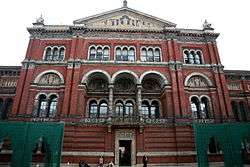
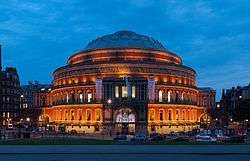
Francis Fowke (7 July 1823 – 4 December 1865) was a British Engineer, Architect and a Captain in the Royal Engineers, who was educated at the School of Military Engineering.[2] Most of his architectural work was executed in the Renaissance style, although he made use of relatively new technologies to create iron framed buildings, with large open galleries and spaces.
Among his projects were the Prince Consort's Library in Aldershot, the Royal Albert Hall and parts of the Victoria and Albert Museum in London, the Royal Museum in Edinburgh, and the National Gallery of Ireland in Dublin. He was also responsible for planning the 1862 International Exhibition in London. Working on the International Exhibition building, described as 'a wretched shed' by The Art Journal; The Crystal Palace at the Great Exhibition of 1851, being a hard act to follow. Parliament declined the Government's proposal to purchase the building; the materials were sold and used for the construction of Alexandra Palace. Before his sudden death from a burst blood vessel, he won the competition for the design of the Natural History Museum, although he did not live to see it executed. His renaissance designs for the museum were altered and realised in the 1870s by Alfred Waterhouse, on the site of Fowke's Exhibition building.
The presentation of the Fowke Medal was instigated by the Institution of Royal Engineers in 1865, as a memorial prize for young officers who demonstrated outstanding architectural ability at the School of Military Engineering. With the demise of great architectural works the prize has been transferred and today it is reproduced in bronze and is awarded to the top student in each of the Clerk of Works (Construction), (Electrical), (Mechanical) and Military Plant Foreman's courses at the Royal School of Military Engineering (RSME).
Brompton Barracks
Records show that there has been a military base on the high ground above Chatham since at least 1708, built to defend Chatham Dockyard.[3]
Brompton Barracks forms the centrepiece of the Brompton Lines Conservation Area, an area designated in 1982 acknowledging the importance of the Chatham Dockyard as having the best-preserved dockyard defences in the country, and a set of historic assets of international significance. Brompton Barracks now forms part of the headquarters of the Royal School of Military Engineering (RSME) and are one of the highest quality Georgian barracks in the country. The Georgian core of the barracks has been enhanced by a collection of 19th and early 20th century buildings and monuments associated with the school and the carefully designed formal landscaping around these structures.
World Heritage Status
Chatham's UNESCO World Heritage Site application is funded by Medway Council, English Heritage and the Chatham Historic Dockyard Trust. Communities and Local Government (CLG) have also made important contributions to project work.[4] Brompton Barracks proliferation of Listed Buildings, museum and historical links to the area and the nation are key elements in the attempt by Chatham to achieve World Heritage status. The RSME is represented on Steering Group of the bid.
Scheduled monument
The Brompton Lines were built in 1755-1757, during the Seven Years' War, to protect Chatham Dockyard from the landward side. The initial construction was in earth. The Lines were improved in the 1780s, during the American War of Independence, when a further French threat was recognised. This work included the defensive ditches with brick retaining walls that still survive today. In 1803 a new magazine and protective Ravelin were built in the north-east corner of the 1780s fortifications. The site of the magazine and Ravelin are outside the boundary of the Scheduled Monument, although their surviving below ground elements have the same historic significance as the other parts of the Lines. The defences were extended to the north-east from 1803–1809, with the construction of the Lower Lines. This work ran concurrently with the construction of the original buildings of Brompton Barracks. Advances in military engineering rendered them redundant by the mid 19th century although they continued in use as a training area until the late 19th century and were sporadically occupied during the First and Second World Wars.
Listed buildings
In addition to the Institute building, built in 1872, Brompton Barracks North, South and West Blocks, flanking the Parade Square are also Grade II* Listed. Following the resumption of war in 1803, the Ordnance Board decided to build new Artillery Barracks, similar to those at Woolwich. Building work was completed in 1806. It was first occupied by Foot Artillery, but the Royal Military Artificers also had a company at Brompton in 1806, and in 1812 it became the Royal Engineers' Establishment.[5] Also included in the building works were stables for 200 horses and sheds for 30 gun carriages.
The Listed buildings in Brompton Barracks are arranged in a formal, mostly symmetrical arrangement that centres on an axis that runs east-south-east to west-north-west through the centre of BR029, through the middle of four Grade II* Listed war memorials and through the middle of the parade ground. The South Africa Arch a memorial to the Corps' dead and wounded of the Boer War was unveiled on 26 July 1905 by King Edward VII. The memorial was constructed by Ingress Bell, starting in 1902, and its construction was subsidised by all ranks of the Corps. The memorial is Grade II* listed. The Crimean War Memorial Arch dates to 1858, the Gordon Memorial to 1890 and the Great War Obelisk.
The HQ 1 RSME Regiment, a former school house, is Grade II* listed.
Organisation

_-_geograph.org.uk_-_1148711.jpg)

The Royal School of Military Engineering (RSME) Group provides a wide range of training not only in all the engineering disciplines that are fundamental to the Royal Engineers, but also Military Working Animals; their handlers and maintainers, Explosive Ordnance Disposal and Military Musicians. The scope of training delivered by the RSME Group is vast ranging from combat engineers to Army musicians, chartered engineers to veterinary technicians and bomb disposal operators to heavy plant operators.
The RSME encourages and promotes a wide range of sporting activities and clubs enabling all personnel to participate either as individuals or as part of a team. All sites have well equipped gymnasiums, squash and tennis courts, hockey, rugby and football pitches. The site at Minley, Surrey maintains a swimming pool in order to enable combat and competitive swimming training.
The RSME Group now consists of a Headquarters based at Chatham, Kent and the following seven Unit commands spread over 6 different locations.
• 1 RSME Regiment (1RSME Regt) Chatham, Kent
• 3 RSME Regiment (3 RSME Regt) Minley, Surrey
• Professional Engineer Wing (PEW) Chatham, Kent
• Royal Engineer Warfare Wing (REWW) Minley, Surrey
• Defence Animal Centre (DAC) Melton Mowbray, Leicestershire
• Defence Explosive Ordnance Disposal, Munitions and Search Training Regiment (DEMS Trg Regt) Bicester and Kineton
• Royal Military School of Music (RMSM) Twickenham
The quest for continuous improvement is driving the modernisation of the design and delivery of the training courses across the RSME Group. Many courses now benefit from modern state of the art technology to support the soldiers learning experience. Course content and training methods are continually reviewed to ensure the RSME Group continues to deliver the required number of highly motivated trained personnel and military working animals in order to meet the requirements of Defence.
The RSME at Brompton Barracks at Chatham is also home to the Royal Engineers Museum and the Institution of Royal Engineers (InstRE).
Training
The Royal Engineer is a military engineer. The training combines the discrete but complementary disciplines of combat engineering and construction engineering which, together, provide the unique range of skills that are fundamental to the Royal Engineers.
These skills include the command and management of engineer tasks; combat engineering; artisan, technical, and professional engineering; counter terrorist search; communication; watermanship; and driving specialist engineer vehicles.
Soldier training
Sappers are firstly trained as a soldier and then as a combat engineer. Many Royal Engineering trades require minimal qualifications on entry; however most trades require individuals to possess good practical ability, technical aptitude and an appetite for continuous learning.[6]
On completion of Phase 1 training, all Royal Engineers proceed to RSME Minley to complete their Phase 2a training in which they will qualify as a combat engineer. In the 9 week long course, soldiers will learn combat engineering skills such as how to clear mines, construct bridges and cross water obstacles. On successful completion soldiers will be awarded their Royal Engineer Stable Belt and officially become a Sapper.[7]
On completion of Phase 2a training, Sappers commence their Phase 2b training. For most trades, this will mean artisan trade training at Chatham in Kent. Course lengths vary and can last up 53 weeks at the end of which Sappers will be posted their first Regiment. For some this will include further training as a paratrooper, commando or EOD specialist. All successful graduates of their Phase 2b courses are awarded a Military Engineer Class 2 qualification for their particular trade.[8]
At some stage during their careers, most Sappers will return to Chatham to continue their professional development. This phase of their training is known as Phase 3. Phase 3 training can be split into 3 main categories: trade training, command and leadership training, and professional engineering.[9]
Officer training
Although more than 80% of officer cadets are university graduates, some are accepted with A-Levels or equivalent qualifications, or are serving soldiers who have been selected for officer training. Age on entry must be between 17 years 9 months and 28 years. Following the 48 weeks of officer training at the Royal Military Academy Sandhurst, Royal Engineer Officers proceed to Command Wing at the RSME, where they complete a 6-month-long Troop Commanders' Course.[10]
The course, which is split between the Minley and Chatham sites, aims to provide the Corps of Royal Engineers with trained and motivated commanders and leaders through operationally focused command and leadership training. With particular emphasis on engineering principles, doctrine and tactics, the training provides the necessary technical, supervisory and administrative knowledge to command engineer soldiers in peace and on operations. On passing the Troop Commanders' Course, officers are posted to their unit, where they will become a Troop Commander. This may entail further training as a paratrooper, commando or bomb disposal officer.
During their commission, high-quality officers may be selected to attend the Battle Captains' Course and/or Squadron Commanders' Course, where they will be provided with the necessary command and supervisory training required to operate effectively in their unit.
Professional engineer training
Professional Engineering Wing delivers advanced technical training to foundation degree standard for selected Junior NCOs and post-graduate learning for officers with engineering degrees to be awarded a MSc degree and be well placed to apply for Chartered Engineer (CEng) status, in order to deliver force infrastructure, reconstruction and development projects on operations. Soldiers who have proved themselves as high quality tradesmen may apply to attend Clerk of Works/Military Plant Foreman courses whilst high quality officers apply to become Professionally Qualified Engineers in order to lead the Corps civil, electrical and mechanical engineering effort.
Other beneficiaries
The RSME Group also provides training for the Royal Navy, Royal Air Force, other Arms and Services of the British Army, Other Government Departments, and Foreign and Commonwealth countries as required. These skills provide vital components in the Army's operational capability.
Mission
The mission of RSME Group is "To deliver the required number of highly motivated trained personnel and military working animals in order to meet the requirements of Defence".
Headquarters RSME
Headquarters Royal School of Military Engineering provides policy, strategy and direction to its seven units. The RSME is commanded by a Brigadier, the Commandant RSME, from the headquarters in Brompton Barracks, Chatham.
The Institute building was built in 1872 and housed the Engineers' college: a central lecture room flanked by specialised teaching rooms. It is now occupied by Headquarters RSME, Headquarters Construction Engineer School and the Corps Library. It is a fine grade II listed building.
The Institution of Royal Engineers is now housed in the Ravelin Building, co-located with the Royal Engineers Museum.
Holdfast Training Services
In a public private partnership (PPP) that will span 30 years, Holdfast Training Services Ltd and the RSME will modernise training and the management of training through the development of new initiatives.
Holdfast Training Services Ltd is a consortium comprising Babcock Support Services Ltd (76%) and InfraRed Ltd (24%), in 2008 a 30-year Public Private Partnership Contract was signed, worth in the region of £3 billion, with the MoD. The contract, which commenced on 5 January 2009, provides the Royal School of Military Engineering with training, training support services, a seven-year build programme as well as hard and soft facilities management services. The design, build and transition phase involves three locations and includes 32 new builds, 21 refurbishments and the development of five training areas.
A 7-year build programme is in nearing completion at Chatham, Kent and Minley, Surrey. This will provide new living and working accommodation including classrooms and Officers', Warrant Officers' and Sergeants' Messes.[11]
Four Junior Ranks Single Living Accommodation blocks are being built - all providing en suite rooms for single occupancy with a sitting room, kitchen and drying area for every 4-5 rooms. Many existing blocks will also be refurbished to provide a similar standard of accommodation throughout the RSME.
"Pay as you Dine" facilities exist at both sites and provide a wide range of hot and cold food for all soldiers and staff. Both sites also have a NAAFI shop, relaxation facilities, licensed bars, internet access, large screen TVs and pool tables.
References
- ↑ Porter, Maj Gen Whitworth (1889). History of the Corps of Royal Engineers Vol I. Chatham: The Institution of Royal Engineers. p.310
- ↑ Royal Engineers' Museum - Francis Fowke
- ↑ Brompton Barracks Cultural Heritage Appraisal
- ↑ Chatham World Heritage and Existing UK World Heritage Sites
- ↑ "The History of Brompton" (PDF). p. 14. Retrieved 22 May 2016.
- ↑ Soldier Training
- ↑ Phase 2A
- ↑ Phase 2B
- ↑ RE Phase 3
- ↑ Officer Training
- ↑ RSME Accommodation - Gallery
External links
- HQ RSME website
- General RSME website
- Holdfast Training Services
- Royal Engineers Museum
- Extreme close-up hi-res aerial photos of RSME Chattenden and Lodge Hill Camp, Chatham, Kent - September 2006
Coordinates: 51°23′16″N 0°31′29″E / 51.38784°N 0.52475°E

